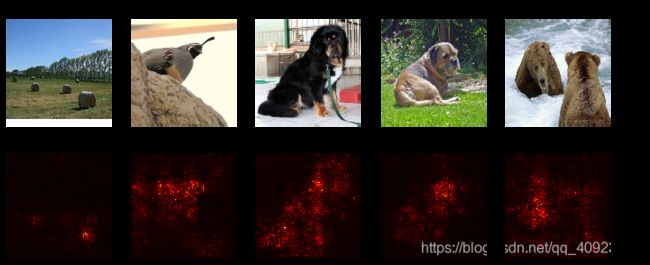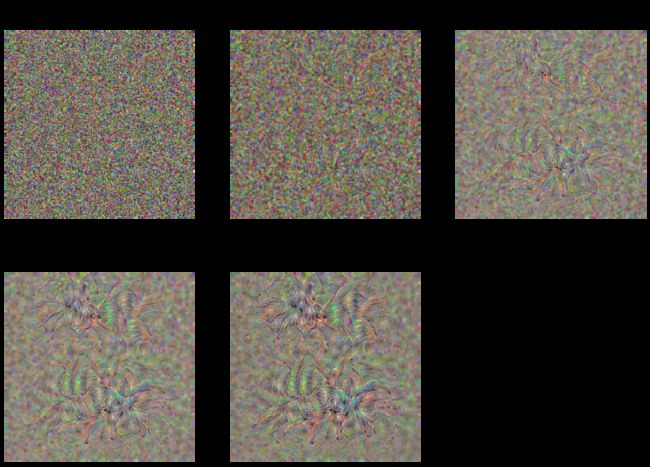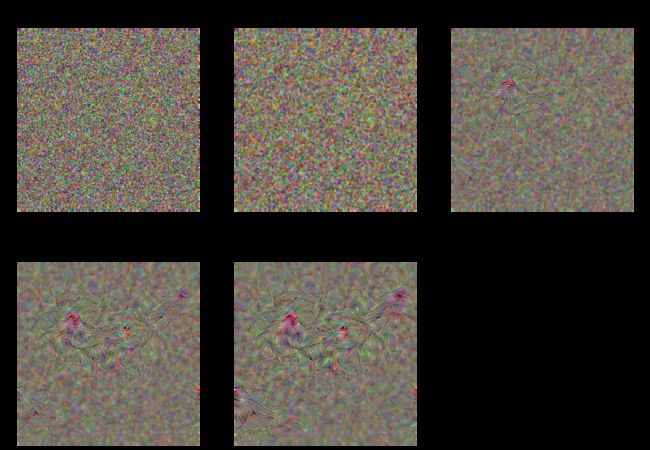【深度之眼cs231n第七期】笔记(二十六)
- NetworkVisualization.ipynb
-
- 预处理
- 显著图
- fooling images
- 可视化类
NetworkVisualization.ipynb
在之前的代码中,我们定义损失来表达模型的满意程度,然后计算每个参数的梯度,并使用梯度下降来最小化损失。
接下来会的代码则不一样:
- 有一个在ImageNet上预训练好的分类模型
- 用这个模型定义损失,用于表达对图像的满意程度
- 计算图像中的每个像素的梯度,使用梯度下降更新图像,使损失达到最小
这里将介绍三种图像生成的方法:
- 显著图:它能告诉我们,图像中哪些地方影响了分类;
- fooling image:修改图像像素,人眼中看到的图像没太大区别,预训练模型却会误分类;
- 类别可视化:生成一张图片去最大化特定类的分数,这能让我们了解神经网络把图片分为某一类时,比较重视什么。
预处理
import torch
from torch.autograd import Variable
import torchvision
import torchvision.transforms as T
import random
import numpy as np
from scipy.ndimage.filters import gaussian_filter1d
import matplotlib.pyplot as plt
from cs231n.image_utils import SQUEEZENET_MEAN, SQUEEZENET_STD
from PIL import Image
%matplotlib inline
plt.rcParams['figure.figsize'] = (10.0, 8.0) # 默认画图大小
plt.rcParams['image.interpolation'] = 'nearest'
plt.rcParams['image.cmap'] = 'gray'预训练使用的数据是经过预处理的(减均值,除标准差),所以定义了一些函数来消除预处理。
def preprocess(img, size=224):
transform = T.Compose([
T.Resize(size),
T.ToTensor(),
# tolist(),将数组或者矩阵转换成列表
# SQUEEZENET_MEAN和SQUEEZENET_STD都是三维数组
T.Normalize(mean=SQUEEZENET_MEAN.tolist(),
std=SQUEEZENET_STD.tolist()),
T.Lambda(lambda x: x[None]),# 增加第0维
])
return transform(img)
def deprocess(img, should_rescale=True):
transform = T.Compose([
T.Lambda(lambda x: x[0]),
# 由于预处理是先减均值再除方差,现在顺序要反过来,写为一条语句的话顺序不对
T.Normalize(mean=[0, 0, 0], std=(1.0 / SQUEEZENET_STD).tolist()),
T.Normalize(mean=(-SQUEEZENET_MEAN).tolist(), std=[1, 1, 1]),
T.Lambda(rescale) if should_rescale else T.Lambda(lambda x: x),
T.ToPILImage(),
])
return transform(img)
# 归一化
def rescale(x):
low, high = x.min(), x.max()
x_rescaled = (x - low) / (high - low)
return x_rescaled
def blur_image(X, sigma=1):
X_np = X.cpu().clone().numpy()
# 分别在图像的长和宽进行一维高斯滤波
X_np = gaussian_filter1d(X_np, sigma, axis=2)
X_np = gaussian_filter1d(X_np, sigma, axis=3)
X.copy_(torch.Tensor(X_np).type_as(X))
return X理论上可以使用任一预训练的网络来生成图片,但是cs231n选了SqueezeNet [1]。因为它达到了AlexNet的准确率的同时,参数量却显著减少(SqueezeNet是轻量级网络中的一个,后来还有ShuffleNet,MobileNet等等)。使用SqueezeNet而不是AlexNet或者VGG或者ResNet意味着可以使用CPU来生成图片。
[1] Iandola et al, “SqueezeNet: AlexNet-level accuracy with 50x fewer parameters and < 0.5MB model size”, arXiv 2016
# 下载并加载预训练的SqueezeNet模型
model = torchvision.models.squeezenet1_1(pretrained=True)
# 我们不希望改变预训练模型的参数,所以让PyTorch不要计算梯度
for param in model.parameters():
param.requires_grad = Falsecs231n提供了一些ImageNet ILSVRC 2012里的验证集图片(把目录换到cs231n/datasets/然后运行get_imagenet_val.sh就可以下载这些图片了),由于图片来自于验证集,所以预训练模型并没有见过这些图片,可视化一些图片和它们的真实标签。
from cs231n.data_utils import load_imagenet_val
X, y, class_names = load_imagenet_val(num=5)
plt.figure(figsize=(12, 6))
for i in range(5):
plt.subplot(1, 5, i + 1)
plt.imshow(X[i])
plt.title(class_names[y[i]])
plt.axis('off')
plt.gcf().tight_layout()显著图
计算正确类得分关于每个像素的梯度,这个梯度告诉我们,如果某个像素稍微改变了,得分会改变多少。
为了计算显著图[2],先对梯度取绝对值,然后取3通道中的最大值。所以最后的显著图的大小为(H, W),并且每个元素都是非负的。
[2] Karen Simonyan, Andrea Vedaldi, and Andrew Zisserman. “Deep Inside Convolutional Networks: Visualising Image Classification Models and Saliency Maps”, ICLR Workshop 2014
提示:PyTorch的gather()方法
回顾Assignment1,有一个从矩阵里选择元素的方法:假设s的大小为(N, C) ,y的大小为(N,) ,包含整数0 <= y[i] < C,那么s[np.arange(N), y] 的大小为(N,)。
在PyTorch中可以使用s.gather(1, y.view(-1, 1)).squeeze()达到同样的效果。关于gather()和squeeze()可以查看文档
# 在PyTorch中使用gather()的例子
def gather_example():
N, C = 4, 5
s = torch.randn(N, C)
y = torch.LongTensor([1, 2, 1, 3])
print(s)
print(y)
print(s.gather(1, y.view(-1, 1)).squeeze())
gather_example()
"""
tensor([[-2.0104, -0.8677, -0.2408, -0.6157, 0.1737],
[ 0.2832, -0.6364, 0.1452, 1.3739, -0.4388],
[ 0.6664, -0.1384, -2.7893, -0.5060, 0.1026],
[-0.7202, 0.5449, -0.2451, -0.9769, -0.3501]])
tensor([1, 2, 1, 3])
tensor([-0.8677, 0.1452, -0.1384, -0.9769])
"""计算显著图
def compute_saliency_maps(X, y, model):
"""
Input:
- X: 输入图像,(N, 3, H, W)
- y: X的标签,(N,)
- model: 一个预训练好的CNN模型
Returns:
- saliency: 输入X的显著图,(N, H, W)
"""
# 确保模型在"test"状态
model.eval()
# 需要求输入X的梯度
X.requires_grad_()
saliency = None
# 前向传播,取出正确类的得分
scores = model(X)
scores = scores.gather(1, y.view(-1, 1)).squeeze()
# 计算梯度,由于损失要是标量,所以求和
scores.sum().backward()
gradient = X.grad
# 计算显著图
grads = gradient.abs()
# 在第1维上比较,也就是红禄蓝三通道上比较
mx, _ = torch.max(grads, 1)
saliency = mx.data
return saliency可视化一些图片的显著图
def show_saliency_maps(X, y):
# 把X,y转换为Torch张量
X_tensor = torch.cat([preprocess(Image.fromarray(x)) for x in X], dim=0)
y_tensor = torch.LongTensor(y)
# 计算X的显著图
saliency = compute_saliency_maps(X_tensor, y_tensor, model)
# 把显著图从Torch张量转化为numpy数组
saliency = saliency.numpy()
# 展示原始图片和显著图
N = X.shape[0]
for i in range(N):
plt.subplot(2, N, i + 1)
plt.imshow(X[i])
plt.axis('off')
plt.title(class_names[y[i]])
plt.subplot(2, N, N + i + 1)
plt.imshow(saliency[i], cmap=plt.cm.hot)
plt.axis('off')
plt.gcf().set_size_inches(12, 5)
plt.show()
show_saliency_maps(X, y)可以看到,红色区域的地方大致覆盖了物体,表明模型能够认出物体的大致位置。

fooling images
可以根据[3]生成"fooling images":给定一张图片和一个目标类,对图像进行梯度上升,使目标类的得分增大,当网络把图片误分为目标类时停止。
[3] Szegedy et al, “Intriguing properties of neural networks”, ICLR 2014
def make_fooling_image(X, target_y, model):
"""
生成一张类似于X的图片,但模型会把它认为是target_y
输入:
- X: 输入图片,(1, 3, 224, 224)
- target_y: 一个整数,范围为[0, 1000)
- model: 一个预训练的CNN模型
输出:
- X_fooling: fooling image
"""
# 初始化图片
X_fooling = X.clone()
X_fooling = X_fooling.requires_grad_()
learning_rate = 1
# 提示:对于大多数的图像来说,生成一张fooling image需要的迭代次数远远小于100次
for i in range(100):
scores = model(X_fooling)
_,predict = torch.max(scores,1)
# 如果达到目的,输出迭代次数,跳出循环
if predict==target_y:
print("end in %d iterations"%(i))
break
target_scores = scores[0,target_y]
target_scores.backward()
g = X_fooling.grad
# 在更新梯度之前,先除以梯度的2范数,防止对图像扰动过大
X_fooling.data += learning_rate*g/g.norm()
# 由于pytorch的梯度并会叠加,所以需要手动对梯度清零
X_fooling.grad.data.zero_()
return X_fooling调用函数生成fooling image
idx = 0
target_y = 6
X_tensor = torch.cat([preprocess(Image.fromarray(x)) for x in X], dim=0)
X_fooling = make_fooling_image(X_tensor[idx:idx+1], target_y, model)
scores = model(X_fooling)
assert target_y == scores.data.max(1)[1][0].item(), 'The model is not fooled!'
# end in 9 iterations展示原始图片,fooling image还有它们的差异。
X_fooling_np = deprocess(X_fooling.clone())
X_fooling_np = np.asarray(X_fooling_np).astype(np.uint8)
# 原始图像
plt.subplot(1, 4, 1)
plt.imshow(X[idx])
plt.title(class_names[y[idx]])
plt.axis('off')
# fooling image
plt.subplot(1, 4, 2)
plt.imshow(X_fooling_np)
plt.title(class_names[target_y])
plt.axis('off')
# 两者的差异
plt.subplot(1, 4, 3)
X_pre = preprocess(Image.fromarray(X[idx]))
diff = np.asarray(deprocess(X_fooling - X_pre, should_rescale=False))
plt.imshow(diff)
plt.title('Difference')
plt.axis('off')
# 两者的差异乘以10倍
plt.subplot(1, 4, 4)
diff = np.asarray(deprocess(10 * (X_fooling - X_pre), should_rescale=False))
plt.imshow(diff)
plt.title('Magnified difference (10x)')
plt.axis('off')
plt.gcf().set_size_inches(12, 5)
plt.show()把干草认成了一种鱼,10倍差异图里,相差较大的地方正是干草存在的地方。

可视化类
从一张随机噪声的图片开始,对目标类执行梯度上升,生成一张能被分为目标类的图片。这个想法是[2]首先提出了的,[4]提供了一些正则化方法来改善生成图像的质量。
是一张图像,是目标类,()是图像关于类的得分。希望生成一张图片 ∗,使(∗)有一个很高的得分,与此同时图像不要变化太大:

其中,

这个任务中会有两个正则化策略:显示的R(I)正则化和隐式的周期性模糊[4]。
[2] Karen Simonyan, Andrea Vedaldi, and Andrew Zisserman. “Deep Inside Convolutional Networks: Visualising Image Classification Models and Saliency Maps”, ICLR Workshop 2014
[4] Yosinski et al, “Understanding Neural Networks Through Deep Visualization”, ICML 2015 Deep Learning Workshop
def jitter(X, ox, oy):
"""
对图像进行随机抖动
输入:
- X: 图像,PyTorch张量,(N, C, H, W)
- ox, oy: 整数,沿w轴和h轴抖动的像素位置
返回: 一个新的PyTorch张量,(N, C, H, W)
"""
# 左右互换
if ox != 0:
left = X[:, :, :, :-ox]
right = X[:, :, :, -ox:]
X = torch.cat([right, left], dim=3)
# 上下互换
if oy != 0:
top = X[:, :, :-oy]
bottom = X[:, :, -oy:]
X = torch.cat([bottom, top], dim=2)
return X可视化类函数
import math
def create_class_visualization(target_y, model, dtype, **kwargs):
"""
生成一张图片,最大化它在预训练模型上的得分
输入:
- target_y: 目标类,整数,范围为[0, 1000)
- model:预训练好的CNN模型
- dtype: Torch数据类型
Keyword arguments:
- l2_reg: L2正则化参数
- learning_rate: 学习率
- num_iterations: 总共迭代多少次
- blur_every: 迭代多少次进行一次平滑(作为隐式正则化)
- max_jitter: 抖动(隐式正则化)多少次
- show_every: 多少次迭代后展示中间结果
"""
model.type(dtype)
l2_reg = kwargs.pop('l2_reg', 1e-3)
learning_rate = kwargs.pop('learning_rate', 25)
num_iterations = kwargs.pop('num_iterations', 100)
blur_every = kwargs.pop('blur_every', 10)
max_jitter = kwargs.pop('max_jitter', 16)
show_every = kwargs.pop('show_every', 25)
# 随机初始化PyTorch张量作为输入
img = torch.randn(1, 3, 224, 224).mul_(1.0).type(dtype).requires_grad_()
# 画图布局所需数据
img_num = 0
# 画图总共有几行
rows = math.ceil(num_iterations/show_every/3)
for t in range(num_iterations):
# 随机抖动会得更好的结果
ox, oy = random.randint(0, max_jitter), random.randint(0, max_jitter)
img.data.copy_(jitter(img.data, ox, oy))
# 计算得分和损失
score = model(img)[0,target_y]
loss = score + learning_rate*img.norm()**2
score.backward()
# 梯度上升
img.data += img.grad
img.grad.zero_()
# 反随机抖动
img.data.copy_(jitter(img.data, -ox, -oy))
# 生成图像像素的上限为hi,下限为lo,区间大约是[-2,3]
for c in range(3):
lo = float(-SQUEEZENET_MEAN[c] / SQUEEZENET_STD[c])
hi = float((1.0 - SQUEEZENET_MEAN[c]) / SQUEEZENET_STD[c])
img.data[:, c].clamp_(min=lo, max=hi)
# 周期性模糊图像
if t % blur_every == 0:
blur_image(img.data, sigma=0.5)
# 周期性地展示图片
if t == 0 or (t + 1) % show_every == 0 or t == num_iterations - 1:
# 计算图片位置
img_num += 1
plt.subplot(rows,3,img_num)
# 展示图片
plt.imshow(deprocess(img.clone().cpu()))
class_name = class_names[target_y]
plt.title('%s\nIteration %d / %d' % (class_name, t + 1, num_iterations))
plt.gcf().set_size_inches(14, 10)
plt.axis('off')
plt.show()
return deprocess(img.cpu())生成一张狼蛛图片:
# dtype = torch.FloatTensor
dtype = torch.cuda.FloatTensor
model.type(dtype)
target_y = 76 # Tarantula狼蛛
out = create_class_visualization(target_y, model, dtype)target_y = 12 # linnet红雀
print(class_names[target_y])
X = create_class_visualization(target_y, model, dtype)

